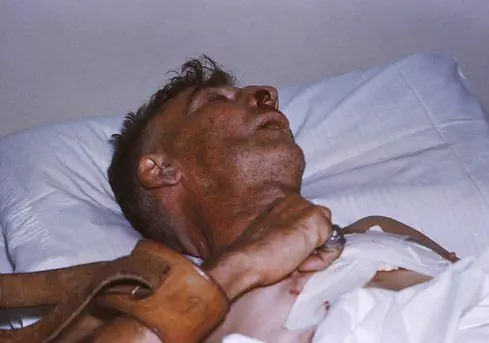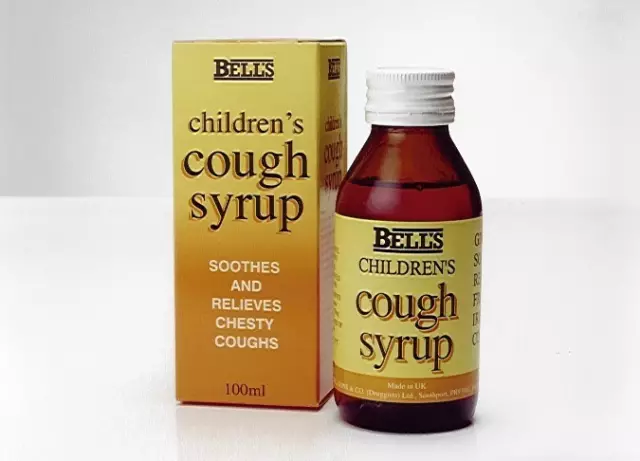- Author Rachel Wainwright [email protected].
- Public 2023-12-15 07:39.
- Last modified 2025-11-02 20:14.
Meningitis in children
The content of the article:
- Causes and risk factors
- Forms of the disease
- Symptoms of meningitis in children
- Diagnostics
- Treatment of meningitis in children
- Possible complications and consequences
- Forecast
- Prevention
Meningitis in children is an infectious and inflammatory disease in which the lining of the brain and spinal cord is affected. For meningitis, a complex of cerebral, general infectious and meningeal symptoms is characteristic.

Meningitis is diagnosed many times more often in children than in adults.
The share of meningitis in the structure of all organic lesions of the nervous system is 27-29%, depending on the epidemic situation. The incidence rate among children under 14 years of age is 10 cases per 100 thousand population. Moreover, in about 80% of cases, children under 5 years of age get sick.
Choroid plexuses, meninges, and ependyma (the membrane that lines the inside of the ventricles of the brain and the central canal of the spinal cord) are the protective barrier of the central nervous system. For this reason, the inflammatory process often affects the membranes of the brain and spinal cord.
The membranes of the brain and spinal cord include hard, arachnoid and soft. Accordingly, during the course of an infectious and inflammatory process in one of the meninges, pachymeningitis, arachnoiditis and leptomeningitis are secreted. If all membranes are damaged, they speak of panmeningitis. The most common inflammation of the soft membranes of the brain and spinal cord.
Causes and risk factors
Infectious agents for meningitis in children can be viruses, bacteria, microscopic fungi, protozoa.
The penetration of the pathogen into the cranial cavity and brain membrane occurs in the following ways:
- household contact (through contaminated items);
- fecal-oral (with food, water);
- airborne (from sick people and carriers of infection);
- transmissible (with bites of blood-sucking arthropods);
- hematogenous, lymphogenous (with blood and / or lymph flow from the affected organs);
- segmental-vascular (along regional vessels from the primary focus of infection, located nearby, bypassing the common bloodstream);
- perineural (along the tissues surrounding the nerves);
- transplacental (from a pregnant woman to a fetus).
Meningitis in newborns can occur when passing through the birth canal, as well as against the background of an unfavorable course of pregnancy and childbirth, intrauterine infection, prematurity, with a lack of oxygen entering the placenta (fetal hypoxia).

The process of getting meningitis
In primary meningitis in children, the entrance gates of infection are usually the mucous membranes of the respiratory and digestive tract. In this case, the source of infection is a sick person or carrier.
In addition, meningitis in children can occur against the background of purulent diseases, childhood infections, acute respiratory viral infections, infectious diseases of the gastrointestinal tract, open craniocerebral and spinal cord injuries, cracks and fractures of the skull base, surgical operations.
The factors contributing to the development of the disease are chronic malnutrition, hypothermia, change in climatic conditions, stressful situations. At risk are children with disorders of the functioning of the nervous system.
In the winter-spring period, the maximum number of cases of meningitis in children is recorded.
Forms of the disease
Depending on the etiological factor, meningitis is distinguished:
- viral;
- bacterial;
- rickettsial;
- spirochetal;
- fungal;
- protozoal;
- helminthic;
- mixed.
By the nature of the inflammatory process, meningitis in children is:
- serous (lymphocytes predominate in the cerebrospinal fluid, the cerebrospinal fluid is transparent);
- purulent (neutrophils predominate in the cerebrospinal fluid, the cerebrospinal fluid is cloudy).

Types of meningitis in children and preventive measures
By pathogenesis, meningitis is distinguished:
- primary (develop as an independent disease);
- secondary (occur against the background of other diseases).
Depending on the prevalence of the pathological process, meningitis:
- limited;
- generalized.
According to the rate of the course, such forms of meningitis in children are distinguished:
- lightning fast;
- sharp;
- subacute;
- chronic.
Depending on the severity, the following forms of the disease are distinguished:
- easy;
- moderate;
- heavy;
- extremely hard.
Depending on the localization of the pathological process:
- pachymeningitis;
- arachnoiditis;
- meningitis;
- panmeningitis.
Symptoms of meningitis in children
The clinical picture of meningitis in different forms of the disease has its own characteristics. Moreover, regardless of the form of the disease, the course of meningitis in children is characterized by the development of cerebral, general infectious and meningeal symptoms.
Among the general cerebral symptoms of meningitis in children, intense headaches are distinguished (they can be bursting, localized in the occipital or frontotemporal region, diffuse, radiating to the neck). Pain sensations are aggravated by sudden movements, light and sound stimuli. There is nausea and vomiting, not associated with food intake (can occur with increased headache, change in body position), while vomiting does not bring relief. Often, children have disorders of consciousness, seizures, weakening of the muscles of one half of the body, and disturbed eye movements.

Meningeal symptom complex in children
General infectious signs of meningitis in children are manifested by a sharp increase in body temperature and chills, tachycardia, and decreased appetite. Breathing is shallow and rapid, the skin is pale or hyperemic, hemorrhagic rashes may appear on the skin.
Meningeal syndrome:
- hypersensitivity to stimuli (hyperesthesia, hyperacusis, uncontrolled contraction of the circular muscle of the eye);
- "Cocked position" - the patient lies on his side, the head is thrown back, the upper and lower limbs are bent;
- stiff neck muscles - due to the tension of the occipital muscles, the patient cannot bend his head and touch the chest with his chin.

Meningeal Pointing Dog Pose
Due to the increased intracranial pressure in meningitis in infants, there is a pronounced venous network on the head and eyelids, as well as bulging of the large fontanelle. In children under 3 years of age, all signs of meningeal syndrome are rare.
Diagnostics
To make a primary diagnosis, collect complaints and anamnesis, an objective examination of the patient. Suspicion of meningitis is an indication for a lumbar puncture with the collection of cerebrospinal fluid samples for biochemical and cytological laboratory studies, as well as for the detection of an infectious agent. In order to identify the pathogen, bacteriological cultures are carried out on the nutrient medium of blood, punctate elements of the rash and material obtained from the mucous membrane of the nasopharynx. The DNA of an infectious agent is determined by examining the cerebrospinal fluid by the polymerase chain reaction method.
Specific antibodies in the patient's blood serum can be determined using methods such as enzyme-linked immunosorbent assay, indirect (passive) hemagglutination reaction, immunofluorescence reaction, and complement fixation reaction.
In addition, X-ray examination of the skull, neurosonography, electroencephalography, magnetic resonance imaging of the brain may be required.

Lumbar puncture is an important method for diagnosing meningitis in children
Differential diagnosis of meningitis in children with traumatic brain injury, neoplasms of the brain, diabetic coma, subarachnoid hemorrhage, arteriovenous malformation, Reye's syndrome is required.
Treatment of meningitis in children
When the initial diagnosis is made, the child is hospitalized in an infectious diseases hospital.
In the acute period of the disease, bed rest, rest and a sparing diet are shown.
The choice of anti-infective drug depends on the type of pathogen. For bacterial forms of meningitis, patients are prescribed antibiotics (intramuscularly or intravenously), in the case of a severe course of the disease, antibacterial drugs can be injected directly into the spinal canal (endolumbar). The duration of antibiotic therapy is on average 1.5-2 weeks. In the case of meningitis of viral etiology, antiviral therapy is performed. With fungal meningitis, antimycotic drugs are indicated. In the protozoal form, antiprotozoal drugs, corticosteroids, antihistamines are prescribed.
In addition to anti-infectious therapy, patients are shown symptomatic and pathogenetic treatment. To reduce cranial pressure, dehydrating drugs are prescribed.
In order to maintain homeostasis, the administration of colloidal and glucose-saline solutions, plasma, albumin is indicated. The use of anticonvulsants, antianemic agents may be required. For the prevention of cerebral edema, diuretic drugs are used (in this case, their ability to flush calcium out of the body must be taken into account). For the prevention of cerebral ischemia, neurometabolic drugs, nootropics are prescribed.
In the case of a severe form of the disease, patients are shown artificial ventilation, oxygen therapy, ultraviolet blood irradiation.
After the completion of treatment, patients require dispensary observation for two years.
Possible complications and consequences
Mild, moderate, and severe neurologic complications can develop with meningitis. Complications of serous meningitis develop less frequently and are easier than purulent ones.

Complications of meningitis in children
Meningitis in children is complicated by the following pathological conditions:
- encephalitis, myelitis;
- swelling of the brain;
- disseminated intravascular coagulation syndrome;
- panophthalmitis;
- epileptic seizures;
- hydrocephalus (in this case, mental disorders, movements, coordination occur, there is a lag in development);
- general or partial violation of the normal pace of mental development (lethargy or increased excitability, aggressiveness, indifference, etc.);
- delayed development of speech in children who have suffered from meningitis before the formation of speech function;
- cerebrasthenic syndrome (manifested by rapid fatigue, increased irritability, sleep disturbances, headaches, and neurotic syndromes);
- minimal cerebral dysfunction (impaired attention, impaired behavioral reactions, which are most noticeable during physical, intellectual and emotional stress).
Forecast
The prognosis of meningitis in children depends on the form and severity of the course of the disease, as well as on the timeliness of diagnosis and the adequacy of the therapy regimen. With a timely diagnosis and properly selected treatment, the prognosis is favorable.
The lethal outcome is registered in 1-5% of cases of the disease.
With an untimely diagnosis of purulent meningitis and resistance of the pathogen to antibacterial drugs, the mortality rate increases tens of times (up to 50%).
Children who have suffered from meningitis are subject to medical supervision with periodic detailed examination (ultrasonography, electroencephalography, echoencephalography).
Prevention
The most effective method that can prevent the development of the disease is vaccination against meningitis in children. It is not included in the vaccination calendar, therefore, it is carried out in two cases:
- at the request of the parents;
- without fail in case of an epidemic situation unfavorable for meningitis.
To protect your child from the most dangerous types of meningitis, vaccination with meningococcal, pneumococcal and hemophilus influenzae vaccines is necessary.
A number of experts believe that before the child reaches two years of age, antimeningitis vaccination is not effective enough due to the age-related characteristics of the immune system. Others believe that vaccination in this case is possible, but revaccination will be required after 3 months and after 3 years.
In addition, in order to avoid the development of meningitis, it is recommended to adhere to a number of measures:
- timely treatment of diseases against which meningitis may develop;
- avoiding contact with people with meningitis;
- compliance with the rules of personal hygiene;
- hardening of the body;
- avoiding swimming in open water, especially with stagnant water;
- avoiding drinking tap water (drink only boiled and / or bottled water);
- wash fruits and vegetables thoroughly before eating.
YouTube video related to the article:

Anna Aksenova Medical journalist About the author
Education: 2004-2007 "First Kiev Medical College" specialty "Laboratory Diagnostics".
The information is generalized and provided for informational purposes only. At the first sign of illness, see your doctor. Self-medication is hazardous to health!






